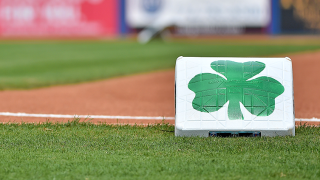
Patrick Sharp never scored a goal for the Blackhawks on St. Patrick’s Day. Neither has Patrick Kane.
In fact, no Patrick has ever scored a goal for the Blackhawks on St. Patrick’s Day. There hasn’t been a hat trick at all, let alone by a Patrick.
The Blackhawks haven’t been all that lucky on St. Patrick’s Day. They are 15-20-3 (W-L-T) all time on March 17.
The Bulls haven’t been particularly lucky on St. Patrick’s Day either, with a 16-17 all-time record. They are 1-0 against the Celtics on St. Patrick’s Day with a 127-121 win in 2009, however. But there have been no Patricks to play for the Bulls.
Then there’s Pat Seerey, who was born on St. Patrick’s Day 1923. He went by Pat, so never mind that his given name was James Patrick Seerey. He may not be the most famous player in White Sox history, but he does hold a distinction. For a player born on St. Patrick’s Day, he’s known not so much for four-leaf clovers, but for four-baggers. Four four-baggers, to be exact. He’s the only White Sox player ever to hit four home runs in a game.
He pulled the feat in Game 1 of a doubleheader in Philadelphia on July 18, 1948.
Acquired a month and a half earlier, on June 2, coming over from Cleveland along with pitcher Al Gettel in exchange for rightfielder/third baseman Bob Kennedy, the 25-year-old Seerey was a career .223 hitter with 74 home runs entering his career day at Philadelphia’s Shibe Park.
News
Batting cleanup for the Sox, left fielder Seerey struck out against 21-year-old right-hander Carl Scheib in the second inning to start his day. That was nothing new; Seerey had led the majors in strikeouts in 1944 (with 99) and 1945 (with 97) and would end up leading the majors again in 1948 (with 102; 15 more than anyone else). But Seerey struck back with a solo homer off Scheib in the fourth inning, a two-run blast off Scheib in the fifth inning scoring Don Kolloway and a three-run jack off Bob Savage in the sixth scoring Tony Lupien and Luke Appling. The name Tony Lupien may not sound familiar to you, but if you’re a pro wrestling fan you know his grandson, John Cena.
That three-run homer gave the White Sox a 9-7 lead, which they would extend to 11-7 but it wasn’t enough. The A’s tied the score in the bottom of the seventh. But Pat Seerey broke the 11-11 tie in the 11th inning with his fourth home run of the game, this time off Lou Brissie (whose own story is incredible – I highly recommend the book The Corporal Was a Pitcher: The Courage of Lou Brissie by Ira Berkow). He was only the fifth player in MLB history with four round-trippers in a game, joining Bobby Lowe in 1894, Ed Delahanty in 1896, Lou Gehrig in 1932 and Chuck Klein in 1936. The White Sox held on to win 12-11, but lost Game 2 of the double-dip by a 6-1 score. Seerey knocked in seven of the 12 Sox runs in the Game 1 win.
The next day in the Chicago Tribune, Seerey was referenced as “the portly member of the White Sox ensemble,” and it was noted that he would be receiving a $500 bonus from a Philadelphia merchant for his power display. The stocky slugger struggled with strikeouts, conditioning and defense, however, and the man often referred to as “Fat Pat” was out of the majors for good after playing just four games for the White Sox in 1949. After his four-homer outburst, he hit only eight more in his MLB career.
It’s tempting to ask what could have been, as Seerey smashed 46 home runs over two levels (including 44 at Colorado Springs) in 1950. In today’s environment perhaps a team would find a way to get his bat into a lineup. Maybe because of his combination of size and power, a nickname such as “World Seereys” would catch on. Either way, Seerey goes down as one of only 18 players in MLB history to hit four home runs in a game. And one of only two players since at least 1904 with multiple games with 15+ total bases. The other is Willie Mays.


